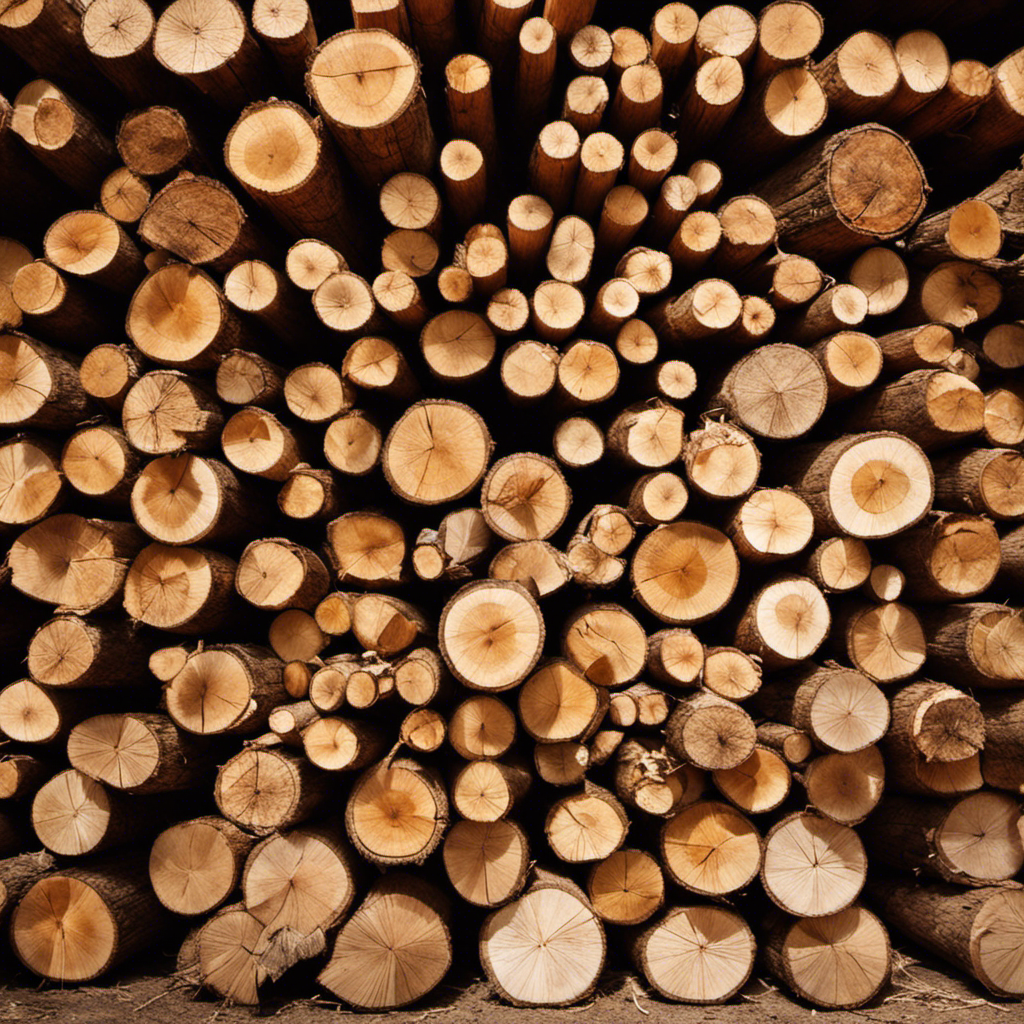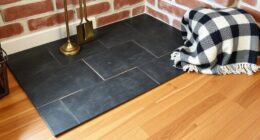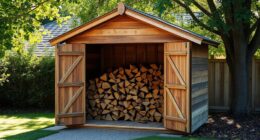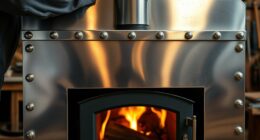Understanding wood stove safety is essential for preventing fires and carbon monoxide poisoning. You should always hire certified professionals for installation and keep a clearance of at least 36 inches from combustibles. Regular maintenance, like annual inspections and cleanings, helps reduce creosote buildup and guarantees efficient operation. Utilize smoke and carbon monoxide detectors for added protection. When operating, use seasoned hardwoods with less than 20% moisture for better combustion. Keep in mind local regulations and best practices for stove usage. By following these guidelines, you'll enhance safety while enjoying effective heat. There's plenty more to explore on this topic.
Key Takeaways
- Regular maintenance and annual inspections are essential to prevent creosote buildup and reduce the risk of chimney fires.
- Ensure a minimum clearance of 36 inches from combustibles to enhance safety around wood stoves.
- Use seasoned wood with less than 20% moisture content for efficient burning and reduced harmful emissions.
- Install smoke and carbon monoxide detectors near the stove for early detection of hazardous gases.
- Compliance with local building regulations and manufacturer guidelines ensures safe installation and operation of wood stoves.
Importance of Wood Stove Safety
Prioritizing wood stove safety is critical for protecting your home and loved ones. Regular maintenance and annual inspections of your wood stove and chimney are essential to prevent dangerous creosote buildup, a leading cause of chimney fires.
For those using modern options, understanding the BTU rating of your stove can also play a role in guaranteeing efficient and safe operation. Make it a habit to check these components yearly.
You should also install smoke and carbon monoxide detectors near your wood stove. These devices provide early warnings about potential hazards, giving you peace of mind.
Maintaining a safe distance—typically 36 inches—from combustible materials is another key safety tip. This simple practice can greatly reduce fire risks associated with wood stove usage.
Following the manufacturer's guidelines for installation and operation is crucial. Doing so guarantees optimal performance and minimizes safety risks, including overheating.
Additionally, being aware of local regulations regarding wood burning is important for compliance and helps you avoid legal issues related to safety standards.
Safe Installation Practices

When installing your wood stove, it's vital to hire certified professionals to guarantee everything meets local building codes.
Additionally, it's important to take into account factors like reputation and reviews from past clients when selecting these professionals.
You should also maintain proper clearance from combustibles and guarantee adequate ventilation for efficient airflow.
These practices are imperative for safe operation and preventing fire hazards.
Professional Installation Required
Professional installation of wood stoves isn't just a recommendation—it's a necessity for safety and compliance. When you opt for professional installation, you guarantee that your setup adheres to local fire codes and building regulations. This minimizes the risk of accidents associated with improper installation, which can lead to dangerous hazards in your home.
Conducting a thorough background check on installers can also provide peace of mind, confirming that you're hiring qualified professionals who prioritize safety. Certified professionals assess your existing chimney's compatibility with the new stove. They verify that flue sizing and positioning meet essential safety standards, optimizing your stove's performance.
During installation, it's essential to maintain a minimum distance of 18 inches from non-combustible surfaces and 36 inches from combustible materials to prevent fire risks. Using non-combustible materials like stone, tile, or brick for the stove's base and backing creates a safe environment for your appliance.
Once your stove is professionally installed, regular maintenance and inspections are important to uphold safety standards and enhance your stove's performance over time. By prioritizing professional installation, you're not just investing in a wood stove; you're investing in the safety and comfort of your home.
Don't take shortcuts when it comes to your family's safety—always choose the professionals.
Clearance From Combustibles
Proper clearance from combustibles is essential for guaranteeing the safe operation of your wood stove. To minimize fire hazards, you need to follow specific clearance guidelines based on the heat output of your stove. Gas appliances, for instance, typically operate without electricity, but it's important to verify that your wood stove is properly installed to avoid any risks.
Here are some important points to take into account:
- Maintain a minimum clearance of at least 36 inches from combustibles for wood stoves with a heat output of 5 kW or more. For stoves rated below this output, ascertain a clearance of at least 18 inches.
- Use non-combustible materials such as brick, tile, or concrete for your stove's base and wall backing. This enhances safety during operation and protects surrounding areas.
- Keep the surrounding area clear of flammable items, including furniture, paper, or curtains. Install your wood stove on a non-flammable surface to further guarantee safety.
Always comply with local building regulations and manufacturer guidelines for proper stove placement and installation.
Regular inspections and maintenance of your stove and chimney are necessary to maintain clearances and prevent creosote buildup, which can lead to chimney fires.
Prioritizing these safety measures will help you enjoy your wood stove with peace of mind. For example, understanding HVAC maintenance can also contribute to a safer home environment.
Ventilation and Airflow
Ensuring your wood stove has adequate ventilation and airflow is key to safe and efficient operation. Proper ventilation prevents smoke from entering your home and supports ideal combustion. If your stove has an output over 5 kW, make sure it's installed with a dedicated air supply or a permanently open vent.
Implementing advanced safety measures can be essential in protecting sensitive information and enhancing your home's overall security posture, much like how AI security provides robust defenses against cyber threats.
The chimney plays an important role in maintaining airflow and draft. It must be correctly sized and positioned, with a minimum clearance of 36 inches from combustible materials to minimize fire risks. Use a non-combustible surface, like brick or concrete, for the stove's base to further enhance safety.
It's crucial to maintain clearances around the stove and keep the area free of flammable materials. Regular inspection and cleaning of the chimney are necessary to prevent blockages and creosote buildup, as these can severely restrict airflow and increase the risk of chimney fires.
Additionally, installing a chimney cap can protect against debris and animals entering the chimney, ensuring proper ventilation and airflow. By following these safe installation practices, you can enjoy your wood stove while prioritizing safety.
Regular Maintenance Tips

To keep your wood stove running safely and efficiently, regular maintenance is crucial. Neglecting this can lead to dangerous situations like chimney fires and carbon monoxide leaks. Here's how you can guarantee your wood-burning stove stays in top shape:
1. Annual Inspections: Schedule a professional inspection of your stove and chimney every year. This helps identify potential issues before they become serious problems.
2. Clean Regularly: Make it a habit to clean your stove and flue at least once a year. If you use your stove heavily, check it more frequently to prevent creosote buildup, which is a leading cause of chimney fires.
Regular maintenance can also enhance the air quality in your home, much like how essential oils improve well-being through aromatherapy practices.
3. Use Seasoned Wood: Always burn seasoned wood with a moisture content below 20%. This not only improves efficiency but also reduces smoke emissions, leading to less creosote accumulation in your chimney.
Additionally, keep a clear area of at least 36 inches around your stove and dispose of ashes in a metal container with a tight-fitting lid.
Store this container outside, away from combustible materials. By following these regular maintenance tips, you'll guarantee a safer, more efficient wood-burning experience.
Health Risks and Precautions

When using a wood stove, you're not just enjoying warmth; you also need to be aware of potential respiratory health concerns and carbon monoxide risks.
Adopting a holistic lifestyle approach, including stress management techniques, can help mitigate some health risks associated with heating your home.
Taking the right precautions, like ensuring proper ventilation and using seasoned wood, can greatly reduce these dangers.
Let's explore how you can keep your home safe while maximizing the benefits of your wood stove.
Respiratory Health Concerns
Wood stoves can pose significant respiratory health risks, particularly if they're not properly maintained or operated. Incomplete combustion of wood can produce harmful emissions, like carbon monoxide and particulate matter, which are especially dangerous for vulnerable populations, such as children and the elderly.
To protect your respiratory health, consider these precautions:
- Use seasoned wood: Verify the wood you burn has a moisture content below 20%. This improves combustion efficiency and reduces smoke emissions, enhancing indoor air quality. monitoring uric acid levels may also help you stay aware of health impacts.
- Regular maintenance: Clean your wood stove and chimney frequently to minimize creosote buildup, which can lead to respiratory issues and increase the risk of chimney fires.
- Install detectors: Place smoke and carbon monoxide detectors near your wood stove for early detection of harmful gases, as timely intervention can prevent serious health complications.
Carbon Monoxide Risks
Carbon monoxide (CO) poses serious health risks that you shouldn't ignore, especially when using wood stoves. This colorless, odorless gas is a byproduct of incomplete combustion, and it can lead to headaches, dizziness, confusion, and even death at high levels.
The U.S. Environmental Protection Agency (EPA) reports that over 20,000 people visit emergency rooms annually due to CO poisoning, emphasizing the importance of proper wood stove maintenance and operation. To further enhance safety, understanding heat pump failures can provide insight into how different heating systems impact indoor air quality.
To minimize CO risks, install carbon monoxide detectors near your wood stove and sleeping areas. These detectors can alert you to dangerous CO levels before symptoms appear.
Regularly inspect and clean your chimney to prevent blockages, as these can cause incomplete combustion and increase CO production in your home.
Using well-seasoned wood with less than 20% moisture content enhances combustion efficiency and reduces harmful emissions, including carbon monoxide.
By ensuring your wood stove operates efficiently and maintaining proper safety precautions, you can greatly lower your risk of CO exposure and enjoy the warmth of your stove safely.
Stay informed and proactive to keep your home and loved ones safe from carbon monoxide hazards.
Understanding Regulations

Maneuvering the regulations surrounding wood stove installations is vital for guaranteeing both safety and compliance with environmental standards.
Since 2022, new regulations in the UK have limited carbon emissions for newly installed wood-burning stoves, emphasizing the importance of air quality. Understanding these regulations can also help mitigate potential personal debt from costly repairs or fines associated with non-compliance, highlighting the significance of financial literacy in home ownership understanding credit card impacts.
To stay compliant and safe, keep these three key points in mind:
- Building Regulations: You must adhere to local building regulations, which include maintaining specified hearth dimensions and using non-combustible materials during installation.
- Ventilation Requirements: If your wood stove has an output greater than 5kW, you'll need a permanently open vent to guarantee adequate air supply and prevent potential backdrafts.
- Inspections and Maintenance: Regular inspections and maintenance aren't just vital for safety; they're legally required to prevent harmful creosote buildup in chimneys and flues.
Additionally, if your property is a listed building, consult with local authorities to navigate any specific regulations.
Best Practices for Operation

To guarantee your wood stove operates safely and efficiently, adopting best practices is vital. Start by using seasoned hardwoods like oak or maple, verifying they're properly dried with a moisture content below 20%. This choice of wood fuel helps your stove effectively generate heat while minimizing smoke production.
Maintaining the combustion zone temperature is essential. Keep it at a minimum of 600°C (1,100°F) to avoid smoldering, which can lead to harmful emissions and creosote buildup. Regularly clean the flue to prevent creosote accumulation, a major cause of chimney fires, and schedule annual professional inspections for ideal safety.
To enhance stove efficiency, try the top-down fire lighting method. Place larger logs at the bottom and kindling on top for longer burns and reduced smoke. Verify proper airflow by adjusting the primary and secondary air controls, which helps regulate the burn rate.
Here's a quick overview of best practices:
| Practice | Description | Benefits |
|---|---|---|
| Use Seasoned Hardwoods | Choose wood with <20% moisture content | Efficient burning, less smoke |
| Maintain Combustion Temp | Keep temperature at 600°C (1,100°F) | Reduces emissions and creosote buildup |
| Clean the Flue | Schedule regular cleanings and inspections | Prevents chimney fires |
| Top-Down Fire Lighting | Stack large logs at the bottom, kindling on top | Longer burns, reduced smoke |
| Adjust Airflow | Regulate primary and secondary air controls | Enhances overall stove efficiency |
Choosing the Right Wood

When it comes to choosing the right wood for your stove, selecting seasoned hardwoods is essential for ideal performance.
Seasoned wood, with a moisture content below 20%, provides 12% more energy than fresh-cut wood, ensuring efficient burning and heat generation.
Here are three key factors to evaluate:
- Type of Wood: Stick to hardwoods like oak, ash, and maple. They burn longer and hotter compared to softwoods, which produce less heat and more smoke.
- Moisture Content: Always check the moisture content of your wood. Seasoned wood should ideally have a moisture level below 20% to optimize combustion efficiency and minimize creosote buildup.
- Storage Conditions: Properly dried wood should be stored in a sunny, covered area for at least six months to a year. This enhances the drying process, reduces smoke emissions, and improves your stove's performance.
Avoid burning treated or painted wood, as it can release harmful chemicals into the air.
Emergency Preparedness

Fire safety starts with being prepared for emergencies related to your wood stove. Regularly inspect and maintain your stove and chimney to prevent hazards like creosote buildup, which can lead to chimney fires. Clean your chimney at least once a year to guarantee ideal safety.
Install smoke and carbon monoxide detectors near your wood stove for early warnings of dangerous situations. This step is vital for the safety of everyone in your household. Additionally, keep a fire extinguisher easily accessible near the stove, and make sure all family members are trained on how to use it effectively in case of an emergency.
Creating an emergency plan is essential. Outline evacuation routes and procedures for dealing with a fire, and make certain that everyone knows the plan through regular drills.
Furthermore, maintain a clear area around the stove, keeping it free from flammable materials. Store any combustibles at least three feet away to minimize fire risks. By taking these precautions, you can greatly enhance your preparedness for emergencies related to your wood stove.
Insurance and Liability Considerations

Installing a wood stove not only enhances your home's warmth but can also impact your insurance coverage.
It's vital to understand how this addition affects your liability and overall policy. Here are three key considerations:
1. Increased Premiums: Wood stoves can present a higher fire risk, potentially leading to increased insurance premiums.
Be prepared for adjustments in your policy costs.
2. Consult Your Insurance Provider: Always inform your insurance agent about the installation of a wood stove.
They might require additional liability coverage to protect against any risks associated with its use.
3. Documentation is Essential: Confirm you have proper documentation of your wood stove installation.
This includes proof of compliance with local building codes and regulations, as it may be necessary for adequate homeowner's insurance.
Frequently Asked Questions
How Do I Know if My Wood Burning Stove Is Safe to Use?
To know if your wood burning stove's safe, inspect it for cracks, check clearances, make certain it's EPA-certified, and use seasoned wood. Regular annual inspections by a professional are essential for maintaining safety and efficiency.
Should the Air Vent Be Open or Closed on a Wood Burning Stove?
When you start a fire in your wood-burning stove, keep the air vent open. This guarantees proper airflow and combustion. Once the fire's strong, partially close it for efficiency, but never shut it completely.
Does Closing the Damper on a Wood Stove Make It Hotter?
Closing the damper on your wood stove doesn't make it hotter. Instead, it restricts airflow, leading to lower temperatures and increased smoke. Properly adjusting the damper is essential for efficient burning and ideal heat output.
What Wood Should You Not Burn in a Wood Burner?
You shouldn't burn treated or painted wood, as it releases toxic fumes. Avoid wet or unseasoned wood, and steer clear of softwoods like pine, which can cause excessive creosote buildup in your chimney.
Conclusion
In your journey to enjoy the warmth of a wood stove, remember that safety isn't just a guideline—it's a necessity. By prioritizing proper installation, committing to regular maintenance, and choosing the right wood, you create a cozy haven. Embrace health precautions, stay informed about regulations, and practice safe operation. Prepare for emergencies, and understand your insurance needs. By taking these steps, you guarantee a safe, inviting fire that warms your home and your heart.











